"Samoprav" simple home spinal traction device
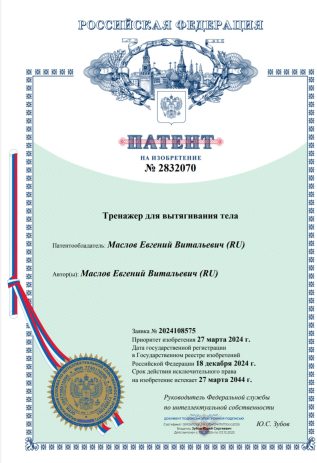
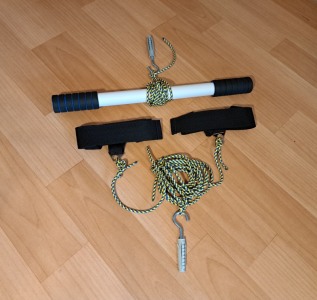
"Samoprav", a simple home exercise machine for self-traction of the spine, relieves back pain in a matter of minutes, and also provides prevention against the development of osteochondrosis and its complications.
This device uses the method of dry longitudinal stretching of the spine.
The design of the mechanism is recognized as an invention and is protected by RU2832070 patent.
To order such an exercise machine, write to e-mail emaslov1@gmail.com with the subject SAMOPRAV
, or in Telegram emaslov1
To purchase a patent or a license for series production, contact the same addresses.
Distinctive properties of the invention
The device possesses unrivaled quality and effect of independent training, quickly relieving back pain:
- The presence of a stretch regulator, allowing you to adjust the current force and dose the load directly during the session.
- Easy-to-remove leg cuffs, providing donning and doffing in a few seconds
- After the session, you can remove the cuffs yourself, without bending over to them and straining your back. This significantly enhances the stretching effect, preventing the spinal muscles from spasming again and causing pain.
- Exercise with the device does not require the presence of an assistant. This is very convenient at home.
- If there are several people in the family, then everyone can exercise on the device without reconfiguring the system for a specific height.
- When folded, the device is very compact and does not take up space in the house.
- The delivery set includes detailed instructions for effective use.
- The design is simple and reliable.
"Samoprav" in working position looks something like this:

The Nature of Osteochondrosis and Radiculitis
Many people experience back pain with age, radiating to the groin and legs.
It is caused by osteochondrosis, an age-related decrease in the strength of the intervertebral discs.
When you bend over, jump, or lift something heavy, the back of the intervertebral discs can move out of place backwards, pinching the bundles of nerves coming out next to them from the spinal cord.
This causes pain and even disrupts the functioning of the nerves.
With age, the strength of the intervertebral discs decreases, and the older you are, the less weight can cause the edges of the discs to move backwards.
The pain from the displaced discs spasms the muscles connecting the vertebrae to each other. The muscles contract even more and put additional pressure on the discs, causing them to protrude even more and cause even more pain.
The positive effects of traction
When longitudinal traction is gently applied to the body, the intervertebral discs are relieved of excess compressive load.
Thanks to this, the edges of the intervertebral discs, which were pushed outward by pathological compression, return to their rightful place under the action of their own elasticity.
Since the edges of the discs no longer press on the nerve roots, the pain quickly goes away.
And when the pain goes away, the spasm of the surrounding muscles connecting the vertebrae also stops. The muscles relax freely and stop unnecessarily pulling the vertebrae together.
After this, the system of vertebrae, discs and muscles returns to its normal state, and the back no longer hurts.
As a rule, a person feels a significant reduction in pain within a couple of minutes after the start of stretching.
The effect lasts for a considerable time after the end of the stretching exercise.
With regular repetition of stretching, stable relief occurs, and even complete recovery is possible.
What does the "Samoprav" stretching device help with?
- From protrusions and intervertebral hernias: in these cases, stretching the body significantly relieves back pain, and with regular exercise it reduces hernias and removes protrusions of intervertebral discs.
- From fatigue and fatigue pain: stretching relieves back muscle fatigue and helps relieve back pain after heavy exercise, lifting weights, loading or excavation work, etc.
- From loss of strength of intervertebral discs and their degeneration. Intervertebral discs are fed by lymph. However, the pressure of lymph in the body is very small. With a sedentary lifestyle or with spasms of the muscles of the spine, excessive compression of the disc does not allow fresh lymph to pass into it. The disc without nutrition loses strength and collapses. Stretching the body removes excess compression from the intervertebral discs, and lymph begins to pass into the disc. Thus, nutrition of the discs is restored, increasing their strength and reducing the risk of developing osteochondrosis.
- From scoliosis and kyphosis, when they are caused by loss of strength of the intervertebral discs.
- From pain in the hip and knee joints, for example, with osteoarthritis. When the body is stretched, the joints of the legs are also stretched, which in certain cases improves the exchange of fluids in them and reduces the pressure of the articular surfaces on each other, thereby reducing pain and promoting the restoration of joints.
Advantages over other types of exercise machines
Today, there are many other types of exercise machines in the world, the manufacturers of which claim the therapeutic properties of their systems.
Let's point out the shortcomings of their designs and the advantage of the "Samoprav" exercise machine over them in these aspects.
Horizontal bar
The horizontal bar is very simple and cheap, and in principle provides some stretching of the body, but it has serious shortcomings that prevent its use for this purpose.
- When hanging, the arms are much higher than the body, as a result, blood flows poorly to them, the arms quickly become numb and tired. Few people who want to stretch their spine can hang on the horizontal bar for more than a minute.
- The force on the arms should be two to three times greater than the resulting force of stretching the spine. While the spine is stretched only by the weight of the pelvis and legs, the arms have to support the full weight of the body of the person exercising. In such conditions, it is impossible to achieve the required stretching duration.
- When jumping off the horizontal bar, the weight of the upper body suddenly begins to press on the intervertebral discs, and the muscles of the spine do not have time to adapt so quickly from stretching to compression. The edges of the disc again move out of place, and the muscles spasm again, returning the pain. As a result, there is no effect from a minute of stretching, and often the condition even worsens.
Unlike horizontal bars, in the "Samoprav" device these problems are successfully solved:
- The arms are at body level and therefore do not go numb.
- The arms only hold a small load that stretches the spine (from 4 to 20 kg). As a result, the arms easily withstand those 15 minutes of stretching that the spine needs to relax the muscles and return the intervertebral discs to their place.
- The load is removed very slowly and smoothly. The exerciser gradually reduces the load using the force regulator, and then releases the bar. The back muscles have time to adapt to returning to a normal state, and this ensures a stable positive effect of the workout.
Traction table
The patient lies on his back on the table, the thoracic region is fastened to the table with belts, and the machine pulls the patient according to the program by the waist or legs. These devices are specially designed for spinal traction, and they usually cope with this task quite well. However, traction tables also have their drawbacks.
- Expensive. Traction tables cost from 2,000 to 120,000 dollars, and for personal use this is too expensive.
- Bulky. A traction table is a large stationary machine, which is very difficult to install in a city apartment, where it takes up an entire room. Therefore, they are usually installed in medical institutions, and ordinary people do not buy them. This means that if you want to use a traction table, you will have to make an appointment and go to a medical center.
- The methods of fastening patients on the table do not always provide sufficient relaxation of the back and spine muscles. Almost always, patients are placed on traction tables with their backs and then fastened with belts. However, since the back continues to feel the supporting surface, it instinctively tries to control the support and does not completely relax.
Unlike traction tables, the Samoprav exercise machine does not encounter these problems:
- The device is very simple and cheap.
- It requires virtually no storage space.
- The recommended exercise position is lying on the chest. In this case, the back is free from the influence of other surfaces, due to which the muscles of the back and spine are completely relaxed.
Inversion table
This device has a stable base to which the table is hinged. The user fastens his legs to the clamps and then tilts the table, moving himself into a head-down position. In this position, the spine is stretched by the weight of the upper body. This type of exercise machine also has its drawbacks:
- Quite expensive ($200 and up)
- Quite bulky. Not as much as traction tables, of course, but they still take up a significant place in the house.
- Exercising upside down is contraindicated for many patients with cardiovascular diseases and high blood pressure.
- The person exercising lies on their back on the table, which prevents the muscles of the back and spine from relaxing.
- After exercising, the person exercising has to bend over to the leg clamps to unfasten their legs. This often causes the back muscles to spasm again and negates the entire effect of the exercise.
The owners of “Samoprav” no complaints about such problems:
- As mentioned above, the device is cheap and very compact, does not take up any space at all.
- Classes are held in the usual position lying on the chest.
- The muscles of the back and spine relax quickly and easily, since the back is completely free.
- After the workout, the student removes the leg cuffs without bending over them, which preserves the positive effect of the workout.
Massagers
Manufacturers of numerous powerful massagers claim that deep massage of the back areas to the right and left of the spine relaxes the muscles and puts the vertebrae and intervertebral discs in their places. However, there is still no physical or statistical evidence for this. Deep massage with hard spikes, causing additional pain to the muscles, can temporarily turn off the pain receptors of the muscles and reduce pain. But this does not mean that after such a massage the vertebrae and discs return to their place.
Unlike massagers, the "Samoprav" exercise machine relaxes the muscles and returns the intervertebral discs to their place by gently stretching the body, without causing any pain to the muscles and without turning off any pain receptors. The pain goes away simply because the condition is normalized and the causes of the pain themselves disappear.
History of the invention of the "Samoprav" device
The history of the development and testing of the spine traction device.
In 2005, after an unsuccessful weightlifting, the inventor was unable to walk due to an attack of pain, since the intervertebral disc in the lower back partially popped back by 10 mm (circled in red in the photos from the MRI of the spine below), pressing on the nerve roots, and in addition, his legs began to go numb, since the hernia partially compressed these roots. No ointments, pills or injections helped.
They did a magnetic resonance imaging.
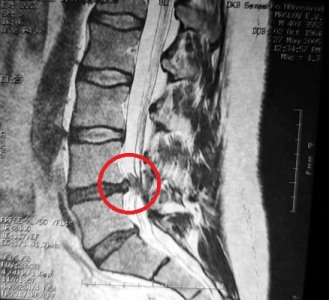
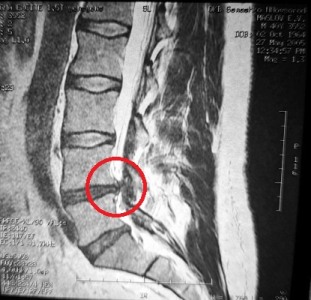
From this tomography, the author was referred to a neurosurgeon for urgent surgery. The part of the intervertebral disc that had slipped back had to be cut off.
However, from the comments on the forums of the operated patients and from the conversation with the surgeon, it became clear that with the existing technologies, the percentage of complications due to postoperative adhesions is very high: the cut disc often grows together with the surrounding muscles or even with the spinal cord, condemning patients to constant pain for the rest of their lives.
The neurosurgeon insisted that hernias do not resolve on their own and that they must be operated on, but the inventor still ran away from the operation.
As an experienced engineer, he realized that, theoretically, if the spine is stretched correctly and the space between the vertebrae is widened, the displaced disc will certainly return to its place under the action of its elasticity.
He tried to stretch his back in different ways: on a horizontal bar, on crutches, pushing his hips with his hands, stretching his back by bending over the back of the bed, etc. All this helped a little, so it added confidence that the direction was correct, but it required a lot of effort from the hands, it was very uncomfortable, and most importantly - it did not allow you to completely relax your back to relieve muscle spasms, move the vertebrae apart and let the discs return to their place. However, after a couple of months of trial and error, the author still came up with a home device consisting of comfortable cuffs on the legs, a crossbar in the hands and a tension regulator. With its help, he could easily and quickly stretch his back with the required force and relax it.
By daily stretching his back with the help of the created device, the inventor completely got rid of lower back pain in two weeks. Then he stretched once a week for a year.
A year later, a control tomography showed that the intervertebral hernia had disappeared, the intervertebral disc had completely retracted back into place (here in the photo from the new control MRI, circled in green).
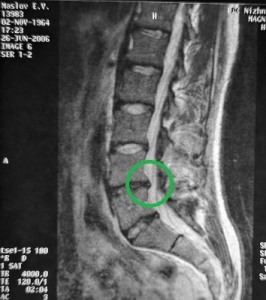
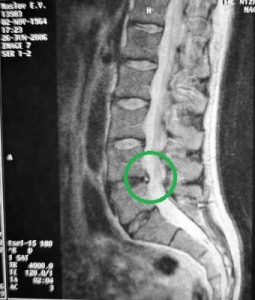
The author subsequently reported on this invention on forums on osteochondrosis, sent the device to those who ordered it, and asked them to report on the results of its use. At the moment, several hundred people have used the device, and almost all of them responded positively to the effect.




